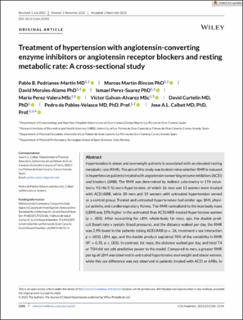| dc.contributor.author | Pedrianes-Martin, Pablo B. | |
| dc.contributor.author | Martin-Rincon, Marcos | |
| dc.contributor.author | Morales-Alamo, David | |
| dc.contributor.author | Perez-Suarez, Ismael | |
| dc.contributor.author | Perez-Valera, Mario | |
| dc.contributor.author | Galvan-Alvarez, Victor | |
| dc.contributor.author | Curtelin, David | |
| dc.contributor.author | de Pablos-Velasco, Pedro | |
| dc.contributor.author | Calbet, Jose Antonio Lopez | |
| dc.date.accessioned | 2022-04-22T11:57:10Z | |
| dc.date.available | 2022-04-22T11:57:10Z | |
| dc.date.created | 2022-03-02T18:10:03Z | |
| dc.date.issued | 2021 | |
| dc.identifier.citation | The Journal of Clinical Hypertension. 2021, 23(12), Side 2106-2114. | en_US |
| dc.identifier.issn | 1524-6175 | |
| dc.identifier.uri | https://hdl.handle.net/11250/2992295 | |
| dc.description | This is an open access article under the terms of the Creative Commons Attribution License, which permits use, distribution and reproduction in any medium, provided the original work is properly cited. | en_US |
| dc.description.abstract | Hypertension in obese and overweight patients is associated with an elevated resting metabolic rate (RMR). The aim of this study was to determine whether RMR is reduced in hypertensive patients treated with angiotensin-converting enzyme inhibitors (ACEI) and blockers (ARB). The RMR was determined by indirect calorimetry in 174 volunteers; 93 (46.5 %) were hypertensive, of which 16 men and 13 women were treated with ACEI/ARB, while 30 men and 19 women with untreated hypertension served as a control group. Treated and untreated hypertensives had similar age, BMI, physical activity, and cardiorespiratory fitness. The RMR normalized to the lean body mass (LBM) was 15% higher in the untreated than ACEI/ARB-treated hypertensive women (p = .003). After accounting for LBM, whole-body fat mass, age, the double product (heart rate x systolic blood pressure), and the distance walked per day, the RMR was 2.9% lower in the patients taking ACEI/ARB (p = .26, treatment x sex interaction p = .005). LBM, age, and the double product explained 78% of the variability in RMR (R2 = 0.78, p < .001). In contrast, fat mass, the distance walked per day, and total T4 or TSH did not add predictive power to the model. Compared to men, a greater RMR per kg of LBM was observed in untreated hypertensive overweight and obese women, while this sex difference was not observed in patients treated with ACEI or ARBs. In conclusion, our results indicate that elevated RMR per kg of LBM may be normalized by antagonizing the renin-angiotensin system. | en_US |
| dc.language.iso | eng | en_US |
| dc.subject | angiotensin | en_US |
| dc.subject | exercise | en_US |
| dc.subject | obesity | en_US |
| dc.subject | overweight | en_US |
| dc.subject | resting energy expenditure | en_US |
| dc.subject | women | en_US |
| dc.title | Treatment of hypertension with angiotensin-converting enzyme inhibitors or angiotensin receptor blockers and resting metabolic rate: A cross-sectional study | en_US |
| dc.type | Peer reviewed | en_US |
| dc.type | Journal article | en_US |
| dc.description.version | publishedVersion | en_US |
| dc.rights.holder | © 2021 The Authors | en_US |
| dc.source.pagenumber | 2106-2114 | en_US |
| dc.source.volume | 23 | en_US |
| dc.source.journal | The Journal of Clinical Hypertension | en_US |
| dc.source.issue | 12 | en_US |
| dc.identifier.doi | 10.1111/jch.14392 | |
| dc.identifier.cristin | 2007087 | |
| dc.description.localcode | Institutt for fysisk prestasjonsevne / Department of Physical Performance | en_US |
| cristin.ispublished | true | |
| cristin.fulltext | original | |
| cristin.qualitycode | 1 | |
